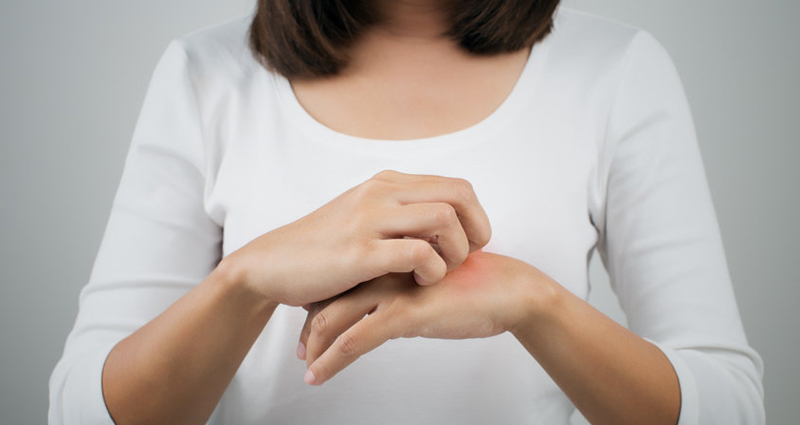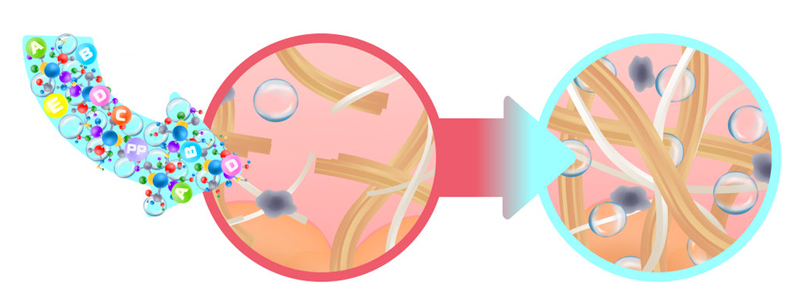
SKIN SENSITIVITY

THE SKIN BARRIER
The skin fence is one of the first lines of protection against external agents, including irritants, allergens, bacteria and viruses, free radicals and UV rays. It is therefore comprehensible how prolonged damage to the skin barrier can represent a risk to the general health of the organism.
The skin is not only a physical fence, but also a functional and selectively permeable one. To guarantee its efficiency, on the outer layer, i.e. the corneum vein, there is a continuous lipid matrix that creates a barrier that prevents the loss and entry of water. This film is made up of cholesterol, free fatty acids and ceramides.
LIPID BARRIER AND SKIN PATHOLOGIES
The film that covers the stratum corneum plays a crucial role and is altered in subjects suffering from skin diseases such as dermatitis and psoriasis.
These skin diseases, however, have deep roots that involve immune de-regulation and chronic inflammation; the latter characterized by an increased and sustained production of pro-inflammatory cytokines and by an important oxidative stress. Apart from genetics and environmental factors, it has emerged that nutrition can play a decisive role in the modulation of the immunological and inflammatory response and, therefore, in the onset of skin diseases related to them.
PSORIASIS AND NUTRIENTS
Psoriasis is an autoimmune, inflammatory, very widespread and pervasive disease, of a multifactorial nature, characterized by an altered regulation of the immune system, both innate and adaptive, which involves the activation of specific classes of cells and the production of pro inflammatory cytokines. In this cascade of events, inflammation plays a fundamental role by promoting the maintenance of this state of altered immune reactivity, as well as the appearance of typical skin lesions and joint involvement (psoriatic arthritis). Since inflammation is modulated by nutrients, it is not surprising that the diet can influence its course. In fact, several nutrients have been examined and in particular fatty acids, vitamins, minerals, and phytochemicals have proven to be a valuable aid in subjects suffering from psoriasis.
OMEGA-3 and OMEGA-6 FATTY ACIDS, ESSENTIAL FOR THE SKIN
Polyunsaturated fatty acids play a crucial role in inflammation and immunity. A diet rich in polyunsaturated fatty acids (omega-3 and omega-6) leads to a decrease in the levels of C reactive protein and interleukin 8, a pro-inflammatory cytokine.
Omega-3 fatty acids are considered molecules capable of decreasing the inflammatory level by competing with omega-6 for the same enzymes; the omega-6/omega-3 ratio, measured in the membrane of the mature erythrocyte, is therefore significant for the maintenance of a healthy metabolic environment. Eicosapentaenoic acid (EPA) and docosahexaenoic acid (DHA) allow a reduction in circulating C reactive protein, a marker of inflammation characteristic of immunological-based diseases.
EPA and DHA are also metabolized respectively into resolvin E1 and D1 with a resolving action of inflammation and, for this reason, they are supposed to have antipsoriatic effects. A diet rich, but controlled, of EPA and DHA, therefore it can improve the inflammation involved in skin lesions.
Food sources of these nutrients are mainly fatty fish such as blue fish, which should be eaten three times a week, prepared in a simple way, without too much seasoning and cooked at temperatures that are not too high for the time strictly necessary.
Among the fatty acids, dihom-gamma-linolenic acid (DGLA) plays an interesting role as regards dermatitis in particular. DGLA is an omega-6, involved and correlated with the health of the skin. DGLA and its metabolites show anti-inflammatory properties and are correlated with ceramide production, thus having a regulatory effect on the functional mechanisms of the skin barrier.
The skin “depends” on the liver for the production of DGLA. Liver health is essential for skin health and, if a deficiency in cell membranes is ascertained, dihom-gamma-linolenic acid can be taken through nutraceuticals, as it is found naturally only in non-food sources ( evening primrose oil and borage oil).

MICRONUTRIENTS
Of great importance for the health of the skin, especially in the case of pathologies mediated by oxidative stress such as psoriasis, are micronutrients and trace elements.
Trace elements are closely related to skin immunity and inflammation and their integration may be a potential target in psoriasis patients.
Zinc is an essential element for the proliferation and differentiation of skin keratinocytes.
Copper is involved in the formation of the extracellular matrix, in the synthesis and stabilization of skin proteins and in angiogenesis. Clinical studies have shown that copper promotes skin elasticity as well as supporting wound healing.
Iron is a catalyst of bioxidation and several studies have shown that ultraviolet radiation and the iron content in skin cells in the postmenopausal period increase very rapidly, reducing the antioxidant capacity of the skin and promoting earlier aging, which weighs on the regenerative abilities of skin lesions.
The lack of selenium in the diet compromises the antioxidant capacity making the skin more sensitive to oxidative stress due in particular to ultraviolet radiation. Selenium and the proteins that bind it are then essential in the development and function of keratinocytes.
VITAMINS
The deficiency of some vitamins affects the antioxidant defensive capacity of the skin. In particular, vitamins A, C, E, powerful antioxidants must never be missing in the diet, which must include yellow and red fruits, red-violet vegetables and nuts. Vitamin B12, contained in all foods of animal origin such as meat, fish, dairy products, eggs, is a nutrient that contributes to maintaining the right balance between oxidative state and antioxidant action.
Finally, vitamin D is a key modulator of inflammation, acting on the monocyte / macrophage ratio, and moderates the production of a series of cytokines responsible for maintaining the inflammatory state.
PHYTO-CHEMICALS
Last but not least are polyphenols, secondary metabolites of vegetables, fruit, tea and olive oil. Due to their evident antioxidant properties, polyphenols should not only represent a fundamental element of the diet, but could be a determining factor for cosmetic skin care. Tea polyphenols, curcumin, flavonoids, grape resveratrol reduce oxidative damage and skin inflammation through their natural antioxidant and anti-inflammatory effects, mainly by inhibiting collagen degradation.
[1] Thulja Trikamjee, Pasquale Comberiati, Enza D’Auria, Diego Peroni and Gian Vincenzo Zuccotti Front. , 12 January 2021 Nutritional Factors in the Prevention of Atopic Dermatitis in Children.
[2] Zuccotti, M. Oliveri, C. Girometta, D. Ratto, C. Di Iorio, A. Occhinegro, P. Rossi Nutritional strategies for psoriasis: current scientific evidence in clinical trials Eur Rev Med Pharmacol Sci Year: 2018 Vol. 22 – N. 23 Pages: 8537 8551
[3] nlm.nih.gov/pmc/articles/PMC7432353/
[4] nlm.nih.gov/30865402/
[5] nlm.nih.gov/pmc/articles/PMC7432353/
- On 29 October 2021



